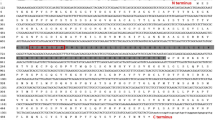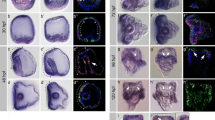Abstract
In this study we investigated expression of the SM30(A–F) gene family encoding Strongylocentrotus intermedius spicule matrix proteins during the normal and regenerative pluteus II stage (three pairs of arms). We found that SiSM30A and SiSM30B genes are expressed at high levels in the normal pluteus II sea urchin. SiSM30A is expression was also significantly upregulated in the reparative pluteus II stage 3 hours after damage. Conversely, SiSM30B was downregulated during the reparative pluteus II stage. Our findings reveal a substantial similarity between the activity of SiSM30A and SiSM30B activity in the processes of regenerative growth during the pluteus II stage and during normal development at the prism stage in Strongylocentrotus purpuratus. On the basis of our findings, we propose that normal developmental mechanisms corresponding to the preceding developmental stage are reactivated during pluteus regeneration.
Similar content being viewed by others
References
Dubois, Ph. and Ameye, L., Regeneration of spines and pedicellariae in echinoderms: a review, Microsc. Res. Tech., 2001, vol. 55, pp. 427–437.
Vinnikova, V.V. and Drozdov, A.L., Spine skeleton morphogenesis during regeneration in clypeasteroid and camarodont sea urchins, Russ. J. Mar. Biol., 2011, vol. 37, no. 4, pp. 311–318.
Dolmatov, I.Yu. and Mashanov, V.S., Regeneratsiya u goloturii (Regeneration in Sea Cucumbers), Vladivostok: Dal’nauka, 2007.
Runnström, J., Analytische Studien über die Seeigelentwicklung, Arch. Entw. Mech. Org., 1915, vol. 41, pp. 1–56.
Vickery, M.C.L., Vickery, M.S., Amsler, C.D., and Mcclintock, J.B., Regeneration in echinoderm larvae, Microsc. Res. Tech., 2001, vol. 55, pp. 464–473.
Horstadius, S., Experimental Embryology of Echinoderms, Oxford: Clarendon Press, 1973.
Thorndyke, M.C., Chen, W.C., Moss, C., et al., Regeneration in echinoderms: cellular and molecular aspects, in Echinoderm Research, Rotterdam: Balkema, 1999, pp. 159–164.
Wilt, F.H. and Ettensohn, C.A., The morphogenesis and biomineralization of the sea urchin larval skeleton, Handbook of Biomineralization, Bauerlein, E., Ed., 2007, vol. 1, pp. 183–210.
Okazaki, K. and Inoué, S., Crystal property of the larval sea urchin spicule, Dev. Growth Differ., 1976, vol. 18, pp. 413–434.
Gould, D. and Benson, S.C., Selective inhibition of collagen synthesis in the sea urchin embryos by a low concentration of actinomycin D, Exp. Cell Res., 1978, vol. 112, pp. 73–78.
Benson, S.C., Benson, N.C., and Wilt, F., The organic matrix of the skeletal spicule of the sea urchin embryos, Cell. Biol., 1986, vol. 102, pp. 1878–1886.
Killian, Ch.E., Croker, L., and Wilt, F.H., SpSM30 gene family expression patterns in embryonic and adult biomineralized tissues of the sea urchin, Strongylocentrotus purpuratus, Gene Exp. Pat., 2010, vol. 10, pp. 135–139.
Mann, K., Proustka, A.J., and Mann, M., The sea urchin (Strongylocentrotus purpuratus) test and spine proteomes, Proteome Sci., 2008, vol. 6, pp. 22–32.
Guss, K.A. and Ettensohn, C.A., Skeletal morphogenesis in the sea urchin embryo: regulation of primary mesenchyme gene expression and skeletal rod growth by ectoderm-derived cues, Development, 1997, vol. 124, pp. 1899–1908.
Wilt, F., Killian, Ch.E., Croker, L., and Hamilton, P., SM30 protein function during sea urchin larval spicule formation, J. Struct. Biol., 2013, vol. 183, pp. 199–204.
Kashenko, S.D., Vyrashchivanie lichinok donnykh morskikh bespozvonochnykh v laboratornykh usloviyakh (prakticheskie rekomendatsii) (Rearing of Benthic Marine Invertebrates under Laboratory Conditions (Practical Guidelines)), Vladivostok: Dal’nauka, 2010.
Kiselev, K.V., Dubrovina, A.S., Shumakova, O.A., et al., Structure and expression profiling of a novel calcium-dependent protein kinase gene, CDPK3a, in leaves, stems, grapes, and cell cultures of wild-growing grapevine Vitis amurensis Rupr., Plant. Cell Rep., 2013, vol. 32, pp. 431–442.
Shumakova, O.A. and Kiselev, K.V., Regulation of somatic embryogenesis in Panax ginseng C.A. Meyer cell cultures by PgCDPK2DS1, Russ. J. Genet., 2014, vol. 50, no. 6, pp. 598–605.
Dubrovina, A.S., Aleynova, O.A., Kiselev, K.V., and Novikova, G.V., True and false alternative transcripts of calcium-dependent protein kinase CPK9 and CPK3a genes in Vitis amurensis, Acta Physiol. Plant., 2014, vol. 36, pp. 1727–1737.
Livak, K.J. and Schmittgen, T.D., Analysis of relative gene expression data using real-time quantitative PCR and the 2(-Delta Delta C(T)) method, Methods, 2001, vol. 25, pp. 402–408.
Ageenko, N.V., Kiselev, K.V., and Odintsova, N.A., Expression of pigment cell-specific genes in the ontogenesis of the sea urchin Strongylocentrotus intermedius, Evid-Based Compl. Alt., 2011, pp. 1–9.
Yajima, M., A switch in tne cellular basis of skeletogenesis in late-stage sea urchin larvae, Dev. Biol., 2007, vol. 307, pp. 272–281.
Gao, F. and Davidson, E.H., Transfer of a large gene regulatory apparatus to a new developmental address in echinoid evolution, Proc. Natl. Acad. Sci. U.S.A., 2008, vol. 105, pp. 6091–6096.
Rafiq, K., Cheers, M.S., and Ettensohn, C.A., The genomic regulatory control of skeletal morphogenesis in sea urchin, Development, 2012, vol. 139, pp. 579–590.
Author information
Authors and Affiliations
Corresponding author
Additional information
Original Russian Text © V.V. Sharmankina, K.V. Kiselev, 2016, published in Genetika, 2016, Vol. 52, No. 3, pp. 339–345.
Rights and permissions
About this article
Cite this article
Sharmankina, V.V., Kiselev, K.V. Expression of SM30(A–F) genes encoding spicule matrix proteins in intact and damaged sea urchin Strongylocentrotus intermedius at the six-armed pluteus. Russ J Genet 52, 298–303 (2016). https://doi.org/10.1134/S1022795416020125
Received:
Published:
Issue Date:
DOI: https://doi.org/10.1134/S1022795416020125




